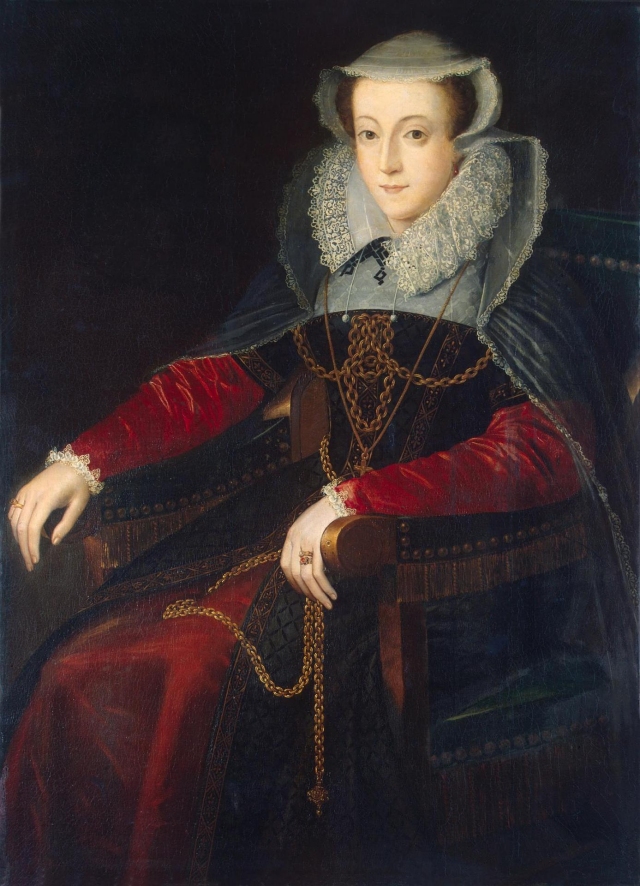Guidebooks now in hand, we follow the arrow, passing by an intricately carved door which features two animals locked in combat: the English lion and Scottish unicorn. Up a wide winding staircase and we have arrived at the upstairs drawing room. Richly decorated with silks and brocades in shades of red, pink and maroon, the walls are festooned with many family portraits.
These portraits amuse me; they all have the same face. The hair and clothing may be varied, but the faces are identical, as if the artist had mass produced them and then added details later. Along one wall, beneath the portraits, stands a harpsichord, pristine in its original condition.
Floors creak beneath our feet as we wander through the hallway that fronts a succession of rooms – a dressing room with a hip bath, a bedroom that holds an elaborately carved cradle where Mary Queen of Scots lay her infant son for the night and the Museum Room, where we spend quite a long time examining all of the artifacts in the glass cases.
All of the items in this room were used by the family through the years. There are many letters which give glimpses into their private lives, political dealings and business affairs. There is also quite a bit of Jacobite memorabilia among many other things, some of them quite odd, such as a sterling silver tongue scraper. I am particularly impressed by a small (about six inches square) illuminated Bible from the 11th century in one case and the petit point embroidery that adorns the walls.
Two libraries are located further along the hallway, one filled mostly with books on philosophy. The portraits of the philosophers are painted on the ceiling around the room and were used as a device for cataloging the books. There is also a reading chair here, which is meant to be sat on backward, as if riding a horse.
From the window of the second library I look out on the gardens, catching sight of the hedge maze behind the house. Childlike excitement sparks through me and I turn to Robin and Dana. "We are going to do the maze aren't we?"
Dana is absorbed in the Jacobite documents spread out over the table and Robin has a peculiar look on her face. I walk over to her, puzzled. "Do you smell that?" she asks in a quiet voice. I take a deep breath and release it slowly. A strong fruity smell, like rotting bananas mixed with the damp mustiness of old books, fills my nostrils. Ugh.
We move on to the next small room, the Priest's Room where we see a secret stairway concealed inside a shelved closet. After the Reformation the resident priest lived in hiding in this room and said Mass for the family and local Catholics. The stairway would have been used by the priest or Jacobite refugees who could descend to the ground floor and leave from a side entrance when the house was being searched.
The air is saturated with malodorous funk as we walk back out into the hallway. Robin and I peer up into the light fixtures looking for heat-released air fresheners, but find nothing. The walls of the hallway are lined with charters, letters and commendations.
There's a great deal of history to be gleaned from these documents, but the smell is starting to make my head pound. Robin's eyes are watering and she sneezes several times in quick succession. We head for the great outdoors and Dana appears soon afterward.

Traquair is a fifty-room house. The rooms include "The King's Room", where Mary, Queen of Scots stayed in 1566 and which contains some relics belonging to her and the Jacobites, such as her rosary, crucifix, purse, a silk quilt, and letters bearing her signature; "The Still Room", where breakfast is taken among the 18th century porcelain that decorates the shelves; and "The Dining Room", one of the last additions to the house, built in the late 17th century.
There is a Roman Catholic chapel built in 1829, following the Catholic emancipation. The 18th century library contains more than 3,000 volumes. Although three lairds made alterations to the house prior to the 17th century, Traquair has changed little, architecturally, since then.
Read more about Traquair House at Wikipedia